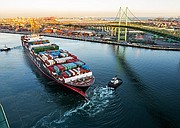IMPORT/EXPORT
Southern California Ports Tell a Tale of Two Traffic Stories
Business at Southern California’s seaports has been looking a little schizophrenic.
In May, cargo-container volumes at the Port of Los Angeles were way up over last year while cargo moving through the Port of Long Beach was way down.
The dichotomy in performance was indicative of the topsy-turvy trade climate that has pervaded the industry ever since the Trump administration last year started imposing tariffs on imported goods coming from China.
At the Port of Long Beach, cargo-container volumes in May were off by 16.6 percent compared to the previous May. A total volume of 573,623 20-foot containers moved through the docks. Imports decreased 19.5 percent to 290,568 20-foot containers, exports declined 15.3 percent, and empty containers shipped overseas dipped 11.7 percent.
Since the beginning of the year, cargo-container volume has slid 6 percent to 3 million containers.
The port’s chief executive, Mario Cordero, said the trade war and escalating tariffs pushed retailers to order goods early, resulting in packed warehouses filled with inventory. “We are hopeful that Washington and Beijing can resolve their differences before we see long-term changes to the supply chain that impact jobs in both nations,” he said.
Another contributing factor, said the port’s spokesman, Lee Peterson, was that an alliance of ocean carriers in recent years has joined forces to share ocean routes and vessels to save money. That means that some ships that might have previously docked in Long Beach in May called instead at the nearby Port of Los Angeles.
For example, Maersk Line and Mediterranean Shipping Co. formed the 2M Alliance and Ocean Network Express; Yang Ming and Hapag-Lloyd formed THE Alliance.
“There may have been a couple of [alliance] services that shifted over to the Port of Los Angeles for May,” Peterson said.
He also noted that cargo volume in May 2018 was particularly high. “It shows when you have a good month one year, it is hard to surpass or even meet it,” he explained.
Meanwhile, the Port of Los Angeles was boasting that another record had been set at its docks. May was the busiest month in the port’s 112-year history with May cargo-container volume jumping 7.8 percent over last year.
“I’m extremely pleased with another record month of throughput and am grateful to our supply-chain stakeholders, terminal operators and unparalleled labor force for their performance,” said Port of Los Angeles Executive Director Gene Seroka. “As we prepare for our traditional peak shipping season in the months ahead, we’re closely monitoring global trade tensions, which have created heightened unpredictability.”
In May, the Los Angeles port saw imports increase 5.5 percent over last year to 427,789 20-foot containers. Exports decreased 0.8 percent to 167,356 20-foot containers, and empty containers were up 20 percent to 233,515 containers.
Since the beginning of the year, cargo-container volumes have increased 5.2 percent.
The twin port complex in Long Beach and Los Angeles is the largest seaport in the United States with 32 percent of the nation’s cargo containers arriving at the two facilities.






















